My journey deeper into the RepRap 3d printers is continuing at a pace. This is good as it is about 14 years since I “quite fancied getting one” but didn’t have a spare £200,000 and the company I worked for couldn’t quite see the point, which at the time was fair enough.
It was in 2006 when I nearly spent a few thousand on one, but bought Second Life islands instead.
Now it is all merging, as predicted. The 3d design of virtual worlds and the tools around those provide a great distribution mechanism for content to be printed. It’s not all completely straightforward but in this Maker Culture we only need a few bits that hook together to put a workable solution in place for most things.
After doing the 3d printing piece on Cool Stuff Collective I said to Malcolm Napier I was up for joining in his Thames Valley RepRap User Group (TVRRUG) as they were gathering a group of people to mass buy and tweak the RepRap Prusa model. The cost of this being well below any other way of doing this, in the hundreds. Whilst its a bit of a trek to go to the meetings (part of this is about socialising the tech) there are plenty of online ways to share. That of course is the point and where being a metaverse evangelist fits in.
I picked up the first parts of the kit from Malcolm last Friday. Then spent a few nights with spanners, youtube and a hammer putting together the first part of the kit. I am primarily a software person, mechanical engineering has never been my strong point, though electronics, soldering etc is or was. So I figured that if I applied myself and got the right tools, with the support of TVRRUG I would be able to make this work.
So it started as a cardboard box of bits. The main structural pieces are metal rods, joints, angles and moving parts have been printed on a reprap (which is the point of the design to self replicate)
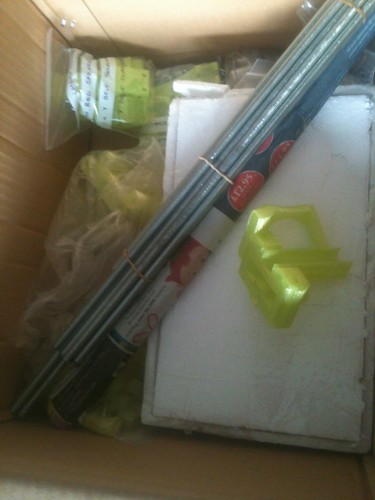
Its gives you a bit of a oh heck where do I start moment as you unbox.
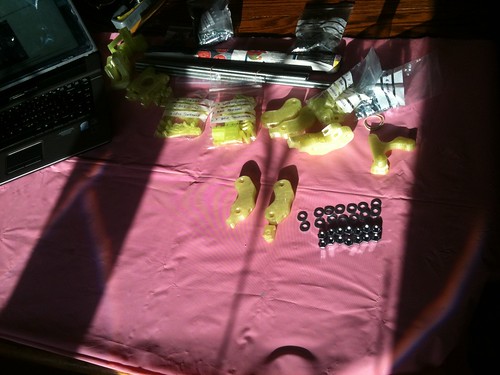
However, the prusa video explanations get you going very quickly. The fixed camera position and clear audio really helps. There is text to read and fall back to but I found the audio and visual worked just fine.
Once the first parts went together…. we were away
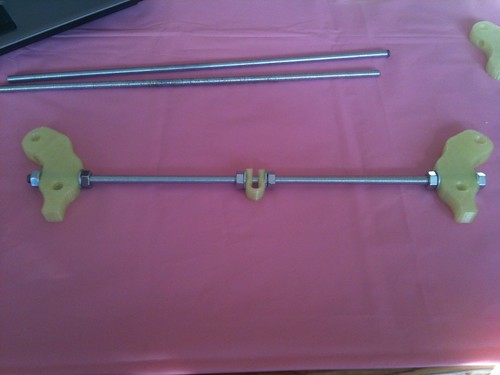
The end triangular structure soon took shape
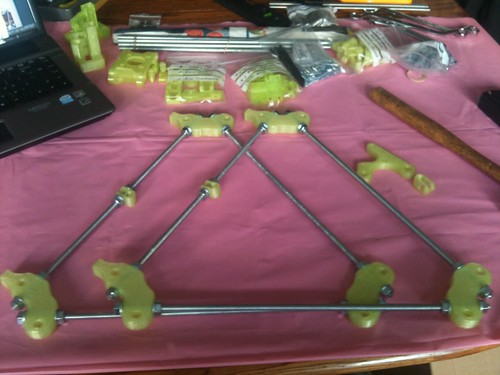
Bearings and motor holders attached to cross beams, washers all over the place
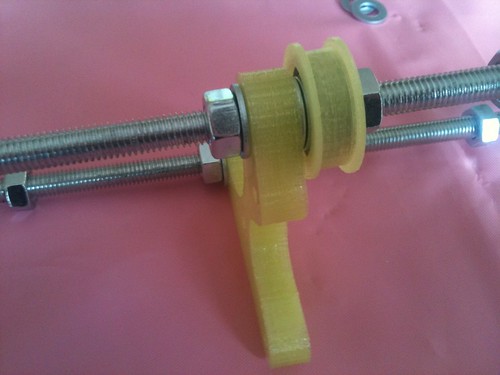
Next the frame started to take its tentative steps to standing upright.
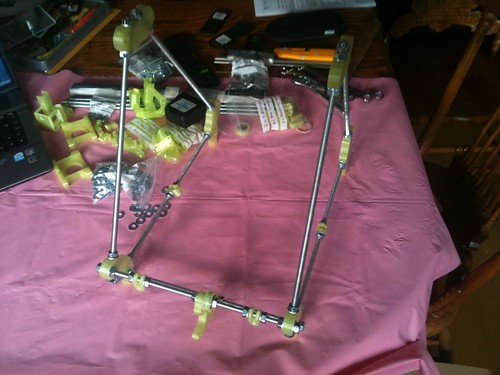
By this stage I realised (and was also being told by the instructions) that getting the measurements correct and squaring off the frame was very important.

It is around this time my software mind thinks… we can get the basics going and revisit performance and tweak it later, but instead an engineering mind thought, for once, no! get the tools measure it properly with verniers callipers and make this thing work as close as possible, and keep revisiting this as bits are added.
(There are two types of good software developer. The precise engineer who builds exactly to spec, very much needed skill and the other sort that builds for flexibility, using the spec as a guideline. Both skills complement one another and you have to know when to do each. I am not suggesting software is a giant bodge, though in many case it may well be)
Having got the frame it was then very exciting to put on the plywood moving platform which has tube bearings. It is here that using tool to make it as accurate as possible (i.e. not a quick look with a tape measure) seems to have paid off. I did have to have a couple of goes and strip this bit down but now have a relatively smooth running platform.

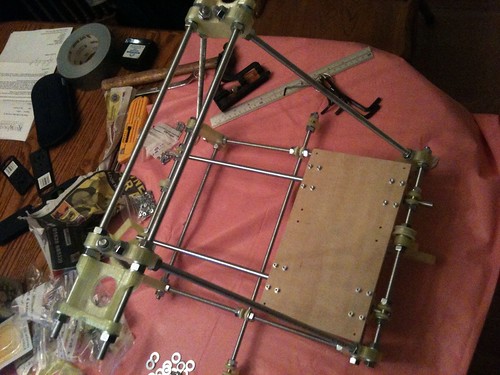
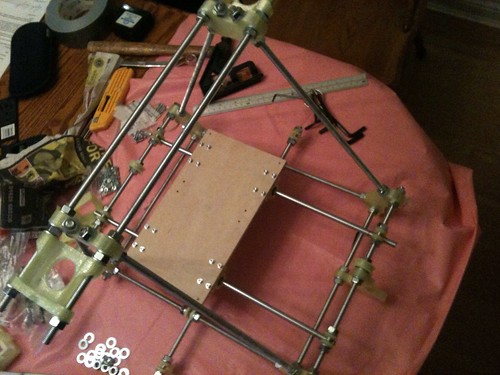
By this time I was on the specific instructions by TVRRUG as we have a slightly wider machine and some parts have been modified, which is the nature of all open source development including mechanical ones.
Last night was the final pieces of this bit of jigsaw with the vertical drive stepper motors the the rods that that lift up and down
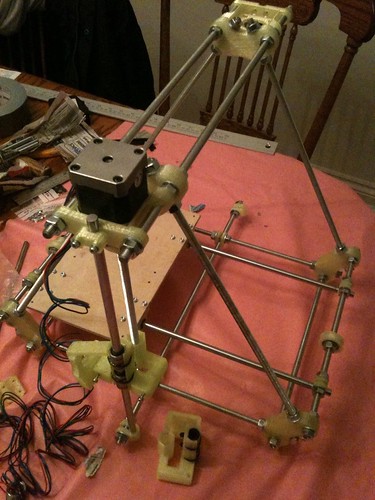
There was a tiny bit of adjustment needed again to make sure things were squared off and equal as putting the final rods for the x axis showed there was a millimetre or so of pushing needed to get the last screw in place. However I think the care in the early stages paid off. I may still have to get more accurate but it feels right, looks right and doesn’t wobble 🙂

So there is it, ready and waiting for the user groups next batch of pieces. Having built one to this stage it would make building another considerably easier.
As with all these things it is good to doing things, to be hands on and not just talk about them. Of course there is a way to go yet but I hope in the not too distant future I can start exploring some of the ways we get things to print. After all I have the haptic device, virtual worlds, minecraft etc all generating the right content.
So I will become a fully fledged fabricaneur. Making things as a business.
Whilst on the subject of 3d printing I also popped along to the Aram Gallery 110 Drury lane. A furniture shop that has a 3d printing exhibition running for a few weeks on its 3rd floor. This is called Send to Print / Print to Send
It had all sorts of examples of 3d printing. It was interesting hearing the comments of some of the other visitors as they tried to figure out the impact of all this. I tried not to dive into the conversations and enthuse at them 🙂
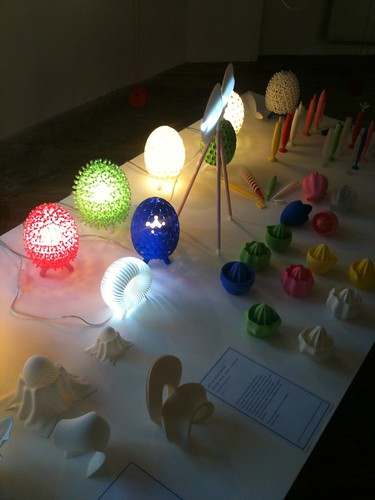


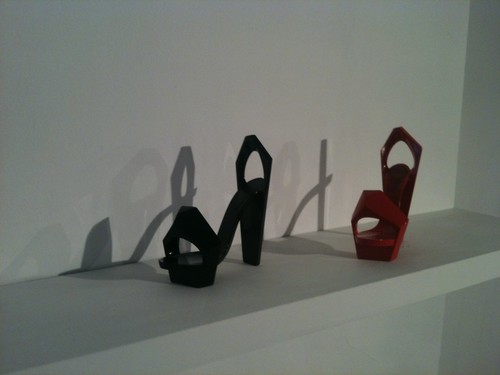
The full set of pictures is here
I was really pleased to see the examples of solar sintering there form the self contained desert machine by Markus Kayser

His video of this experimental art form was going down rather well earlier in the year.
The gallery was showing a number of videos including this one of the work.
They also had a fully completed reprap there, a slightly different model to mine but great to see one close up again and take the time to look at it, with a more experience eye onto its construction.

3dprinting
The future of tech education – ICT upgrades to open source
In the final show of Cool Stuff Collective series 3 I put forward my wish for 2012, which actually occurs at 20:12 in the show that ICT in schools needed a revamp (there a few days left before this rotates from the player, I don’t have the rights to youtube it AFIAK yet). Now I am not the first person to say this about ICT, and I was adding to the many voices both of the various tech industries, reports to government UPDATE* The Royal Society have just release a report too here* and those teachers bypassing some of the ICT curriculum to get kids actually skilled in computer science and building with technology. Yesterday the government minister for education Michael Gove gave a public speech at the BETT education conference that indicated that all the pressure was working. Admitting that ICT was not working, was boring the kids and was leading to a crippling loss of hi tech skills in the UK.
There is a full transcript of what was said here and of course it features general political sound bites. yet the core of it is positive as far as I can see.
Two things stood out for me.
1.”That’s why, rather than focusing on hardware or procurement, we are investing in training individuals. We need to improve the training of teachers so that they have the skills and knowledge they need to make the most of the opportunities ahead.”
2. “An open-source curriculum
Advances in technology should also make us think about the broader school curriculum in a new way.
In an open-source world, why should we accept that a curriculum is a single, static document? A statement of priorities frozen in time; a blunt instrument landing with a thunk on teachers’ desks and updated only centrally and only infrequently?
In ICT, for example, schools are already leading the way when it comes to using educational technology in new and exciting ways – and they’re doing it in spite of the existing ICT curriculum, not because of it.
The essential requirements of the National Curriculum need to be specified in law, but perhaps we could use technology creatively to help us develop that content. And beyond the new, slimmed down National Curriculum, we need to consider how we can take a wiki, collaborative approach to developing new curriculum materials; using technological platforms to their full advantage in creating something far more sophisticated than anything previously available.”
1. Is about people, teaching teachers, industry getting involved to help and
2. is an amazing alteration in the view that the processes and interactions are open source as much as the actual technology itself. Something many of us in the emerging tech and open source world already know and share.
It could be seen as dropping responsibility for ICT but I think this will work out, as most collaborative ventures as activists with clear positive ideas making changes and that will naturally drag everyone along.
As you know I try and not just talk about things but do take a bite out of technology so you don’t have too and this has all coincided with some observations and activities by my kids, aka the predlets. Predlet 1.0 is 8, Predlet 2.0 is 5 (just about). Yesterday Predlet 1.0 was not well in the morning so ended up not going to school. Rather than veg out in front of the TV I put minecraft on for her. Yes a game, but also with some other properties.
With a few hours of focus she got to do things other than just build blocks. She tried survival/crafting mode for a while and learned how hard it was to manage resources, this made her appreciate the open world of creative mode where all the blocks and resources are available to you all the more. Having switched to creative mode she started to explore the functioning blocks. Minecraft has mechanical and electrical components in it. Very soon there were switches and pressure plates opening and closing doors, mine carts propelled by red ore repeaters on rails, some needing more power to go up hill etc.
When Predlet 2.0 came home from school he was keen to join in so it was time to get computers running and a local minecraft server. This then meant the two of them were in their own virtual world, together. Where the actions of one impacted the other. They talked about it a lot and started to build a house. This was a collaborative build in a location they felt was best for the house. By a river near some mountains with a lush forest around it. 1.0 the showed 2.0 how the switches and mechanisms worked on doors.
This is the result. Viewed from my minecraft as I too can attach to our server and see how things are getting on.
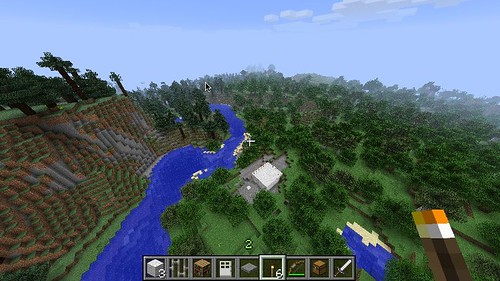
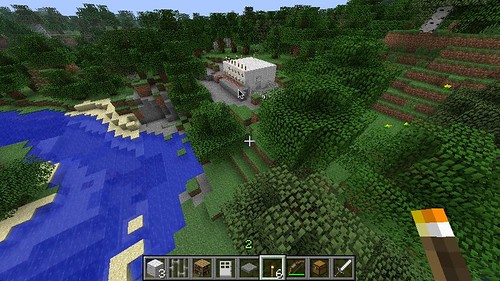
Here there is a pressure plate in front of and behind the door to “automate it”
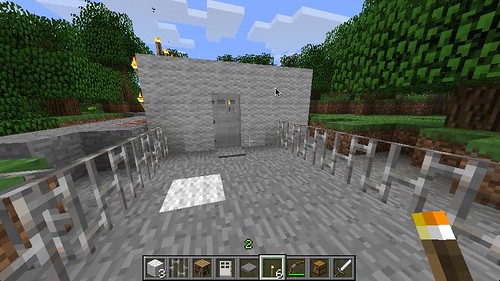
The small room has a bed each and also notice a bookcase as books are important

Whilst running this multiplayer setup across our network there was a crash. I was on a call so tech support was closed for 30 mins. They used their initiative and got the server going again, though were foiled by passwords on the clients, so instead switched to offline play on their own individual worlds until I was free.
Now this may not be a regular lesson, I am not a teacher. Yet this covered an awful lot of ground.
a)In world they were moving around in 3d space, aware of one another. There were creating and removing 3d block objects, choosing from inventories. So the mechanics of a metaverse, just like being in Second Life or OpenSim were in full use.
b)They were collaborating on a single project, dividing the tasks up, one did the walls whilst the other did the floor.
c)They chose a location near water and other resources, which to all intents and purposes is a geography lesson!
d)They shared how to start to build machinery, basic physics and mechanics and to some degree electronics, and implemented those together.
e)When there was a tech failure they attempted to resolve it, understood there was a server component that was brokering the 2 clients. When that did not work they worked out a fall back resolution. They now also are starting to ask about general systems management and how interconnected processes need to be kept running.
f)They enjoyed it immensely.
For me seeing a multiplay sandbox creative environment like this running is yet more of the same that we had with Second Life back in 2006 when we started to use the environment to communicate and share ideas. Back then we wanted our own servers for privacy and control. That spun out into things like Opensim which exists today. The pattern is the same with minecraft though it has more of a game feel and reason for existing, yet this creative mode becomes about building. Why build? well answers a) to f) above should be a good reason.
We are obviously a tech g33k family, and social exclusion from technology does worry me. However… put this sort of thing in schools to get kids interested in the first place? Those that like sys admin will gravitate towards the power of running servers. Those with a design eye will build interesting things, the engineers will make machines and understand cause and effect. Then of course there is the growth of 3d printing, the digital things can also become real products. Online social skills and etiquette will grow. It does not have to be minecraft, there are lots of ways to do this. It does not even have to be a specific tailored experience.
These things are there, available, not science fiction. There are also those of us out here ready to help because we have tried some things out. So the future looks bright doesn’t it?
Another virtuous loop in 3d printing/metaverses
It is a few years back now that we started to see applications that would print our digital 3d designs form Second Life out into physical form. Now the current king of user generated content in a 3d multi user virtual world toolkit/game (metaverse) – Minecraft, is getting the same treatment.
Eric Haines has created an open source package to help go from the digital blocks of Minecraft to a file format suitable for 3d printing.
Whilst there is a pursuit of mesh reality in Second Life, smooth curves flowing lines Minecraft’s charm is that everything looks blocky, but you can still be creative in the use of those blocks and colours. (i.e. there is a prim and its a cube (there are a few extra shapes 🙂 ). It is so far way from the uncanny valley, yet it is actually full of valleys in its digital representations.
What I think is great is that its the same cycle as in 2006, in 2011/12 but with even more buy in at the game level, and lots of education uses. Plus this time around we have services like Shapeways to print with.
More please 🙂
Cory Doctorow warns DRM is just a mini boss to defeat
It should be no surprise that Cory Doctorow has thought this all through but in his recent presentation at 28c3 he talked about The Coming War on General Computation – The copyright war was just the beginning. What was interesting is that it was based on extrapolating the current war on copy protection, DRM and the film and music industry attempting to control how and what we see and hear based on the use of copyright. I is speech he points out that this is almost an minute replica of what is going to happen to the whole of society that far out weighs anything as insignificant as whether a song is copied or not.
There is a transcribed version here too
The premise is that of control. Those wanting to control how or what you do with something versus you wishing to use it how you want. He points out that appliances are often restricted computers. The computer can do everything, but it is not allowed to by root kits or other mechanisms that stop that particular computer doing what it could do.
You could view this as a simple case of buying the thing you want to do the thing you want. Processes that you do not want to be running on your appliance are outside your control, for your own good. Which of course may mean its just easier to use, or that you are being manipulated either financially at first or politically as a regime seeks to stop you doing things it considers detrimental to its existence.
So it seems we trade freedom for convenience. At some point that could come back to remove any freedom to trade?
The current arguments over SOPA are another escalation in the copyright wars. The internet is being looked at as something that needs filters and controls by those who need to filter and control. In doing that it breaks the internet. It threatens open source development (which of course has always threatened large corporate entities), it threatens creative expression (which of course can point fingers, be satirical and root out hypocrisy) the list goes on. Yet is it there to stop a few people stealing some things that maybe are not worth being stolen?
That is not to say there is not a problem with real thrift and real criminality that happens to occur on the internet and computers in general, but…. do we lock up everyone in jail so no-one commits any crimes?
There was a particularly good tale of unintended consequences, which is really what happens with all this sort of regulation and control, it may be well meaning to start with but messes things up.
From the transcript https://github.com/jwise/28c3-doctorow/blob/master/transcript.md (CC-BY Joshua Wise)
[[931.2]] This kind of superficial resemblance and underlying divergence happens in other engineering contexts. I’ve a friend who was once a senior executive at a big consumer packaged goods company who told me about what happened when the marketing department told the engineers that they’d thought up a great idea for detergent: from now on, they were going to make detergent that made your clothes newer every time you washed them! Well after the engineers had tried unsuccessfully to convey the concept of “entropy” to the marketing department [audience laughs], they arrived at another solution — “solution” — they’d develop a detergent that used enzymes that attacked loose fiber ends, the kind that you get with broken fibers that make your clothes look old. So every time you washed your clothes in the detergent, they would look newer. But that was because the detergent was literally digesting your clothes! Using it would literally cause your clothes to dissolve in the washing machine! This was the opposite of making clothes newer; instead, you were artificially aging your clothes every time you washed them, and as the user, the more you deployed the “solution”, the more drastic your measures had to be to keep your clothes up to date — you actually had to go buy new clothes because the old ones fell apart.
It was also this piece about hearing aids that struck a chord (again CC-BY Joshua Wise)
[[1627.8]] As a member of the Walkman generation, I have made peace with the fact that I will require a hearing aid long before I die, and of course, it won’t be a hearing aid, it will be a computer I put in my body. So when I get into a car — a computer I put my body into — with my hearing aid — a computer I put inside my body — I want to know that these technologies are not designed to keep secrets from me, and to prevent me from terminating processes on them that work against my interests. [vigorous applause from audience] Thank you.
This was because a family member recently went to have a hearing exam and in that the doctor “upgraded” the existing hearing aid to work on the audio loop facility that you have in banks and cinemas. It seemed strange that this feature, which already existed, had not been enabled by default? It makes you wonder what else is in that device or any other?
So next time you have a copyright argument, as Cory says, think of this a the mini boss towards the end of the level that we get to practice on before the mega boss at the end.
Cool Stuff Collective RepRap 3D printing
Today The 3d printing (part ii) aired on The Cool Stuff Collective. A huge shout out of thanks goes to Malcolm Napier and his daughter Hannah (who has built most of the machinery) for bringing along their collection of RepRap 3d printers and getting it all working so well so quickly. Including the dicussions on which colour plastic we should use for the best impact. (Blue in this case 🙂 )
Also thankyou to @AndyPiper for the intro’s via Reading Geek Night. A particular unsung hero award to producer Ros who manages to make all the arrangements and get things to make these items work.
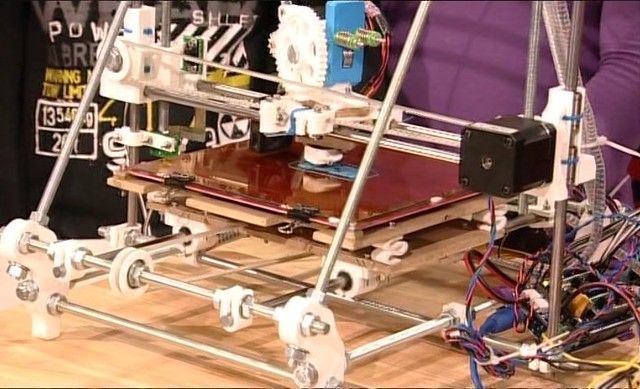
The kids at the school we filmed at were enthralled as were the Archie productions crew, with the printer actually working. That is always a good sign when you are going to be showing some future tech.
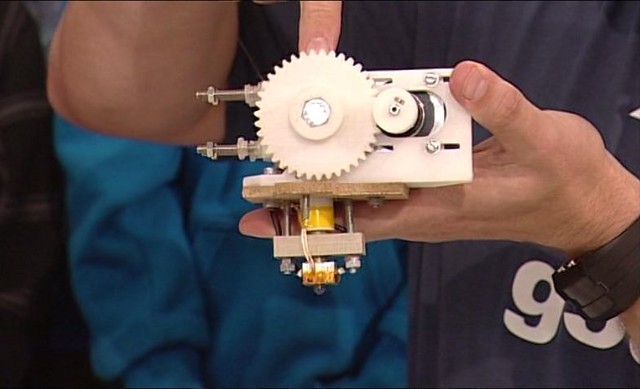
In the piece we talked about how the printer worked, how the reprap is designed as an open source project that aims to replicate one printer from another. I also threw in the massive change to manufacturing and the planet of replicating what you need locally. No packaging, shipping, wasted manufacture. It’s a huge concept, but the kids watching the show will be living in a world where that is even more important.
We also talked a bit about bio printing, though I did point out thats not with a reprap (yet!). Vicky brought in the kids questions, which were all their own too. One in particular about why is this different from a lathe was great 🙂
Now a set of reprap bits costs about £300, so I think that every school should be making one in science lessons and then learning about how to craft 3d objects.
The kids loved the g33k tokens. it was almost the start of a new craze 🙂
Malcolm and Hannah created the g33k text 3d model, whilst we had lots of taller bigger samples we could print it was better to have a relatively thin but constantly repeating model to not cause massive continuity errors or problems for when they get edited up by series producer Jenny. If you can imagine printing a tall tower some takes, and doing 2 takes of the piece and trying to weave the best parts of each together. With my ad hoc non scripted presentation it would mean the tower would keep changing height. We also did not want to keep stopping and starting the reprap. Though it would cope it was better to just film whilst it was running.
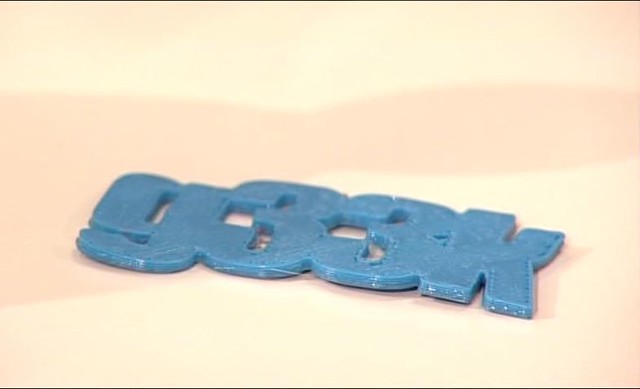
If you are in the UK and you want to see the show it is on the ITV player for the rest of the week.
I would love the show to be out there for a wider audience as I am really happy with what we have been doing the past few series and it feels it is getting better all the time.
If it can help and inspire just a few people back into science, or open up some creative maker talent out there then I think we are doing a good job.
It seems an age away from that first show, and my “debut” as a boffin in the luvvie world (to quote google’s boss Schmidt). Yet it was only a year ago, but over 30 shows of future tech already in the can(or memory stick)!
Roll on monday/tuesdays recordings!
